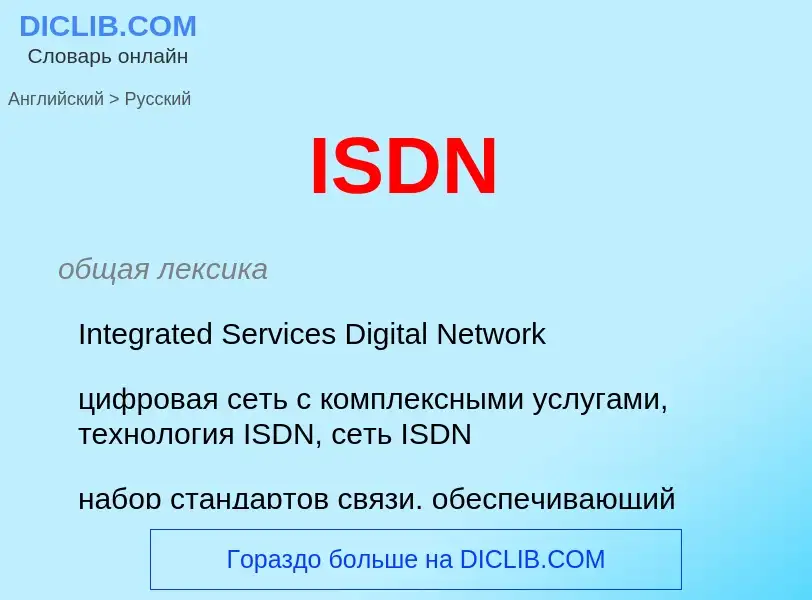ترجمة وتحليل الكلمات عن طريق الذكاء الاصطناعي ChatGPT
في هذه الصفحة يمكنك الحصول على تحليل مفصل لكلمة أو عبارة باستخدام أفضل تقنيات الذكاء الاصطناعي المتوفرة اليوم:
- كيف يتم استخدام الكلمة في اللغة
- تردد الكلمة
- ما إذا كانت الكلمة تستخدم في كثير من الأحيان في اللغة المنطوقة أو المكتوبة
- خيارات الترجمة إلى الروسية أو الإسبانية، على التوالي
- أمثلة على استخدام الكلمة (عدة عبارات مع الترجمة)
- أصل الكلمة
ISDN - ترجمة إلى إنجليزي
общая лексика
Integrated Services Digital Network
цифровая сеть с комплексными услугами, технология ISDN, сеть ISDN
набор стандартов связи, обеспечивающий высокоскоростную передачу по цифровой линии различных типов данных: текстовых, цифровых, звуковых, видео и др. В стандартах на ISDN определены два типа доступа: первичный интерфейс обмена (PRI) и базовый интерфейс абонента (BRI). Оба интерфейса используют каналы двух типов: B channels и D channel. По каждому B-каналу со скоростью 64 кбит/с передаётся голос, данные или видео, а 16 кбит/с D-канал используется для сигнализации, например передачи вызова и разрыва связи
(Integrated Services Digital Network) интегральная цифровая сеть связи с комплексными услугами
ويكيبيديا

Integrated Services Digital Network (ISDN) is a set of communication standards for simultaneous digital transmission of voice, video, data, and other network services over the digitalised circuits of the public switched telephone network. Work on the standard began in 1980 at Bell Labs and was formally standardized in 1988 in the CCITT "Red Book". By the time the standard was released, newer networking systems with much greater speeds were available, and ISDN saw relatively little uptake in the wider market. One estimate suggests ISDN use peaked at a worldwide total of 25 million subscribers at a time when 1.3 billion analog lines were in use. ISDN has largely been replaced with digital subscriber line (DSL) systems of much higher performance.
Prior to ISDN, the telephone system consisted of digital links like T1/E1 on the long-distance lines between telephone company offices and analog signals on copper telephone wires to the customers, the "last mile". At the time, the network was viewed as a way to transport voice, with some special services available for data using additional equipment like modems or by providing a T1 on the customer's location. What became ISDN started as an effort to digitize the last mile, originally under the name "Public Switched Digital Capacity" (PSDC). This would allow call routing to be completed in an all-digital system, while also offering a separate data line. The Basic Rate Interface, or BRI, is the standard last-mile connection in the ISDN system, offering two 64 kbit/s "bearer" lines and a single 16 kbit/s "delta" channel for commands and data.
Although ISDN found a number of niche roles and some wider uptake in specific locales, the system was largely ignored and garnered the industry nickname "innovation subscribers didn't need." It found a use for a time for small-office digital connection, using the voice lines for data at 64 kbit/s, sometimes "bonded" to 128 kbit/s, but the introduction of 56 kbit/s modems undercut its value in many roles. It also found use in videoconference systems, where the direct end-to-end connection was desirable. The H.320 standard was designed around its 64 kbit/s data rate. The underlying ISDN concepts found wider use as a replacement for the T1/E1 lines it was originally intended to extend, roughly doubling the performance of those lines.




